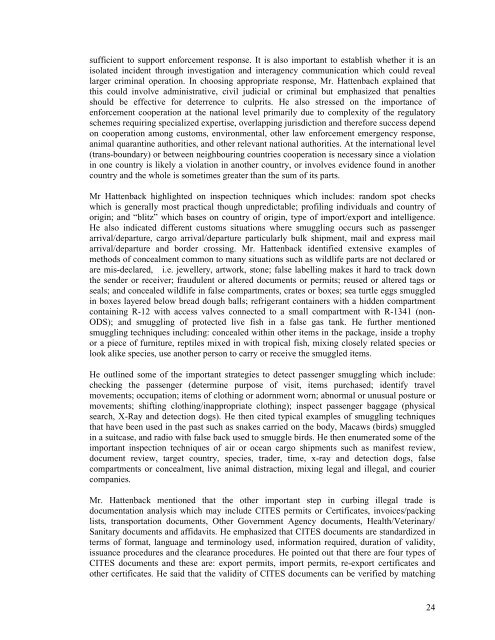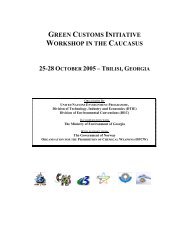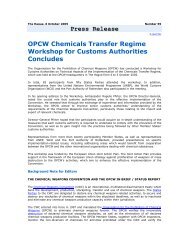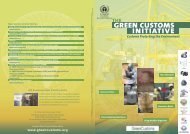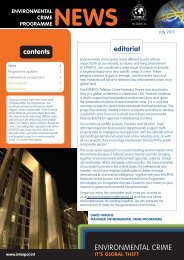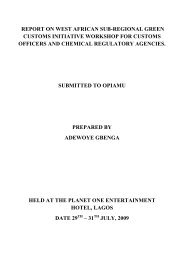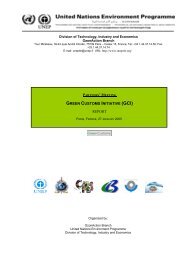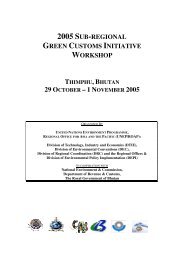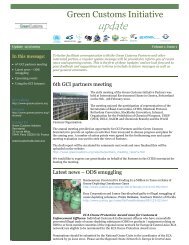Arusha - Green Customs Initiative
Arusha - Green Customs Initiative
Arusha - Green Customs Initiative
You also want an ePaper? Increase the reach of your titles
YUMPU automatically turns print PDFs into web optimized ePapers that Google loves.
sufficient to support enforcement response. It is also important to establish whether it is an<br />
isolated incident through investigation and interagency communication which could reveal<br />
larger criminal operation. In choosing appropriate response, Mr. Hattenbach explained that<br />
this could involve administrative, civil judicial or criminal but emphasized that penalties<br />
should be effective for deterrence to culprits. He also stressed on the importance of<br />
enforcement cooperation at the national level primarily due to complexity of the regulatory<br />
schemes requiring specialized expertise, overlapping jurisdiction and therefore success depend<br />
on cooperation among customs, environmental, other law enforcement emergency response,<br />
animal quarantine authorities, and other relevant national authorities. At the international level<br />
(trans-boundary) or between neighbouring countries cooperation is necessary since a violation<br />
in one country is likely a violation in another country, or involves evidence found in another<br />
country and the whole is sometimes greater than the sum of its parts.<br />
Mr Hattenback highlighted on inspection techniques which includes: random spot checks<br />
which is generally most practical though unpredictable; profiling individuals and country of<br />
origin; and “blitz” which bases on country of origin, type of import/export and intelligence.<br />
He also indicated different customs situations where smuggling occurs such as passenger<br />
arrival/departure, cargo arrival/departure particularly bulk shipment, mail and express mail<br />
arrival/departure and border crossing. Mr. Hattenback identified extensive examples of<br />
methods of concealment common to many situations such as wildlife parts are not declared or<br />
are mis-declared, i.e. jewellery, artwork, stone; false labelling makes it hard to track down<br />
the sender or receiver; fraudulent or altered documents or permits; reused or altered tags or<br />
seals; and concealed wildlife in false compartments, crates or boxes; sea turtle eggs smuggled<br />
in boxes layered below bread dough balls; refrigerant containers with a hidden compartment<br />
containing R-12 with access valves connected to a small compartment with R-1341 (non-<br />
ODS); and smuggling of protected live fish in a false gas tank. He further mentioned<br />
smuggling techniques including: concealed within other items in the package, inside a trophy<br />
or a piece of furniture, reptiles mixed in with tropical fish, mixing closely related species or<br />
look alike species, use another person to carry or receive the smuggled items.<br />
He outlined some of the important strategies to detect passenger smuggling which include:<br />
checking the passenger (determine purpose of visit, items purchased; identify travel<br />
movements; occupation; items of clothing or adornment worn; abnormal or unusual posture or<br />
movements; shifting clothing/inappropriate clothing); inspect passenger baggage (physical<br />
search, X-Ray and detection dogs). He then cited typical examples of smuggling techniques<br />
that have been used in the past such as snakes carried on the body, Macaws (birds) smuggled<br />
in a suitcase, and radio with false back used to smuggle birds. He then enumerated some of the<br />
important inspection techniques of air or ocean cargo shipments such as manifest review,<br />
document review, target country, species, trader, time, x-ray and detection dogs, false<br />
compartments or concealment, live animal distraction, mixing legal and illegal, and courier<br />
companies.<br />
Mr. Hattenback mentioned that the other important step in curbing illegal trade is<br />
documentation analysis which may include CITES permits or Certificates, invoices/packing<br />
lists, transportation documents, Other Government Agency documents, Health/Veterinary/<br />
Sanitary documents and affidavits. He emphasized that CITES documents are standardized in<br />
terms of format, language and terminology used, information required, duration of validity,<br />
issuance procedures and the clearance procedures. He pointed out that there are four types of<br />
CITES documents and these are: export permits, import permits, re-export certificates and<br />
other certificates. He said that the validity of CITES documents can be verified by matching<br />
24


